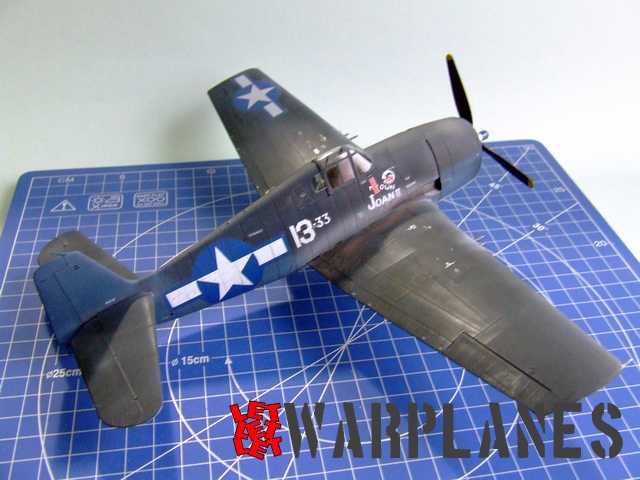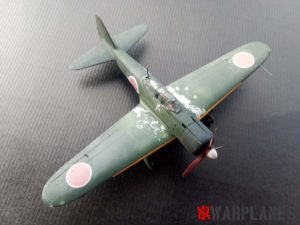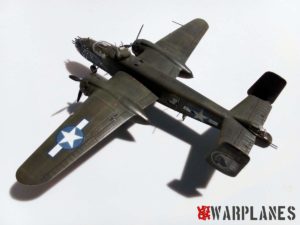Grumman Hellcat Eduard re edition
Eduard release again their older kit of Grumman Hellcat and it have stock code 8221 and scale is 1/48. We have this kit review before and kit with markings of Vraciu was published here.

Aircraft with BuNo 40467 was flown by one of the US Navy’s most successful pilots, Lt. Alexander Vraciu (more to follow). Classified as ‘war weary’ and expired, the airframe was retired on August 29th, 1944, and transferred to the Naval Air Technical Training College in Chicago. Even after the decommissioning of this unit, the aircraft served as an airworthy condition at the beginning of the nineties, with the civil registration G-BTCC. Alex Vraciu himself attended the rollout ceremony that has allowed his Hellcat to fly today just as it did in 1944.instructional airframe for another twenty
years. attended the rollout ceremony that has allawed his Hellcat to fly today just as it did in 1944. This helped in saving Vraciu’s Hellcat from the scrapheap, and was later thoroughly rebuilt, and became part of ‘The Fighter Collection’ in Great Britain. This organization reconstructed the aircraft to airworthy condition at the eginning of the nineties, with the civil registration G-BTCC. Alex Vraciu himself attended the rollout ceremony that has allawed his Hellcat to fly today just as it did in 1944.
History of Hellcat (from Eduard assembly instruction)
There are few aircraft types that took part in combat during World War Two, that can be described with such one sided outcomes in terms of kill : loss ratio as the Hellcat. Representing the middle of the Grumman Cat lineage, the Hellcat was a unique type right from its beginnings. Success of its older brother, the Wildcat, which carried on its shoulders the bulk of the strain of the Pacific air war in 1942, prompted the US Navy to give Grumman free reign over the independent development of a new fighter. This type was to act as insurance in the event the concept of the F4U Corsair turned out unsuccessful. Grumman designers set forth with the design, with emphasis on ease of manufacture, performance and suitability for carrier ops. On the 30th of June, 1941, as Corsair production was initiating, the Navy signed an order for two prototype XF6F-1s, and a star was born.
Original expectations centered around development of the proven F4F Wildcat, which was to be dominated by installation of more powerful engines. As such, this eventually evolved into a new fighter altogether. The US Navy also had accumulated combat experience, and was able to incorporate pilot suggestions into the design. The Hellcat was some 60% heavier than the Wildcat, was more heavily armed, had a more powerful engine, was more heavily armored, carried more fuel and was generally of a more robust construction. The first prototype took to the air on June 26th, 1942, and by January, 1943 equipped the first Navy unit, Vf-9, on the deck of the Essex.
The new type was called Hellcat. The name not only suggested the place to which her enemies would be sent, but was also a play on words. The term in the old west referred to barroom brawlers, and that was what the Navy wanted: a tough fighter with hard fists, that could absorb punishment and had stamina. The Hellcat line didn’t result in the most elegant of fighters. It was, after all, over twice as heavy as its main adversary, the Japanese A6M Zero.
But elegance certainly doesn’t play a pivotal role in terms of the potential survival of the pilot. It was a fighter first and foremost in every sense of the word, designed around the requirements of the pilot to fulfill the combat mission for which it was designed and he was trained. The initial version, F6F-3, was supplanted by the dash five, which modified the canopy, cowl, bomb racks and drop tanks. The first combat engagement of the enemy occurred on September 1st, 1943, when an Emily was flamed by the half inch guns of two Hellcats. Their advantage over Japanese fighters was well demonstrated on
February 16th, 1944, when, in the vicinity of Truk, over 100 fighters were claimed in the air and over 150 on the ground for the loss of four aircraft. Five days later, in the Marianas, a further 160 enemy aircraft were destroyed in the air and on the ground Often one sided combat was documented in the battle for the Philippine Sea that culminated on June 19th, 1944 in the now legendary ‘Great Marianas Turkey Shoot’, where Hellcat pilots claimed some 350 enemy aircraft destroyed. A further turkey hunt took place between October 12th and 14th, 1944 over Formosa, seeing the destruction, at the hands of Hellcat pilots, of 300 enemy aircraft for the loss of 27.
In October, 1944, the Japanese began to escalate night attacks, bringing on a requirement for night fighters to counter them. USAAF P-61s were too far off. Night fighting variants of the Hellcat were introduced in the form of the F6f-5N and F6F-3N, equipped with radar. This new role for the Hellcat first appeared at the end of fall, 1944 during the intensification of kamikaze attacks, that required the interception of unorthodox attacks by aircraft that avoided air to air combat. Other major combat was seen over the Japanese islands over the first half of 1945.Although the Hellcat was progressively replaced by its stablemate F4U Corsair, it served in the combat role up to the end of the war. Under the designation Hellcat FMk 1 and II, several hundred served with the Royal Navy, notably in the Atlantic covering convoys, and also in the Far East.
According to statistics, there were 12275 Hellcats of all versions made. For the loss of 270 of these, Hellcat pilots claimed 5156 kills. That accounts for over half of USN and USMC victories. The Hellcat also became the most successful carrier based fighter in the Pacific in under two years of ops. Lumbering, awkward at first glance, lacking in elegance, barroom brawler – wild, tough, a fearless hulk, able to clear a saloon before turning three times…..that was the Hellcat in the skies over the Pacific.
Markings options
A. F6F-3, Probable BuNo 66016, VF-16, USS Lexington, Hawaii, September, 1943
During intense training on Hawaii, VF-16 aircraft, in the August to September 1943 timeframe, carried the older, red-outlined national insignia that was soon after discontinued. VF-16 aircraft carried the emblem ‘The Pistol Packin’ Airdales’ under the cockpit on both sides of the fuselage. The emblem bearing the red and white shirt was the first incarnation used during initial operational cruises. The battle crest of the new Hellcat unit went into action in the area of the Tarawa Atoll and the Gilbert Islands in mid-September, 1943, by which time the red borders of the national markings were over painted with blue.
B. B. F6F-3, BuNo 25813, Lt. C.K. ‘Ken’ Hilderbrandt, VF-33, Ondonga, December, 1943
One pilot to escort the Hellcat to its baptism of fire at Guadalcanal and the Solomon Islands was San Francisco native Lt. C.K. Hilderbrandt. He became a fighter pilot in 1941, became an instructor, and joined fighter unit VF-1 by 1943. Shortly thereafter, he was reassigned to VC-16, subsequently transferred to VF-33. Hilderbrandt achieved his first three aerial victories on August 14th, 1943, while escorting 72 Dauntlesses and Avengers against Ballale, flaming three Zekes. By the end of his tour, he gained a total of five kills. On his return home, he again became an instructor with the status of fighter ace. All of Lt. Hilderbrandt’s kills were achieved on the illustrated aircraft, ‘My Own Joan II’. The Hellcat carries the characteristic three cooling flaps on either side of the cowl and exhaust fairing, denoting the oldest production series. This plane doesn’t carry the antennae wire or the front antenna mast. Instead, the aircraft is equipped with a whip antenna, common on ground based aircraft.
C. F6F-3, BuNo 40090, VF-1, Lt. William C Moseley, USS Yorktown, June, 1944
This Hellcat, of VF-1 ‘High Hats’, was a replacement aircraft flown by Lt. Moseley, who lost his original mount in the Battle of the Philippine Sea on June 19th, 1944. On that day, he gained two confirmed victories and one probable, but in an attempt to land his damaged plane back on the deck of his carrier, it was lost overboard. This battle was part of intensive combat with the Japanese from May 29th to August 2, 1944, during which VF-1, flying off the USS Yorktown, claimed the destruction of some 100 aircraft in the air and over another sixty on the ground. The rather carelessly applied number ‘090’ (‘890′?) was left over from the transport of the airplane to the unit, and was supposed to have been replaced with the unit’s insignia. Unfortunately, it never came to that, as Lt Moseley was shot down over the Bonin Islands on July 4th, 1944, and was listed as MIA. His name appears on a memorial in Honolulu. The cowl of this aircraft was of the newer type, with two cooling flaps on either side of the cowl, but still with the exhaust fairing.
D. F6F-3, BuNo 40467, Lt. Alexander Vraciu, VF-6, USS Intrepid, February, 1944
“Gadget”, one of the planes flown by one of the US Navy’s most successful pilots, Lt.Alexander Vraciu, is from the end of 1944, beginning of 1945 time period, when Vraciu flew as a member of VF-6 off the deck of the USSIntrepid. By that time, he was already an ace, and was nearing the end of his first combat tour.He attributed his success to, among others, his CO and mentor, Edward O’Hare, first ace of the USNavy, and for whom he flew as wingman. Vraciu claimed his first Zero on October 10th, 1943 over Wake Island. One of his most successful days came on January 29th, 1944, when he flamed three Betty bombers. Joy over his even greater success of downing three Zekes and a Rufe over Truk on February 17th, 1944, was tempered by the fact that his carrier, the USS Intrepid, had been torpedoed. The carrier survived, but had to put into Pearl Harbor for repairs. Vraciu completed his tour as the unit’s most successful pilot. After some R and R, he began his next tour with VF-16 and VF-20, and he finished the war with 19 kills. The cowl of this aircraft points to being of a later series F6F-3, with only two of the cooling flaps on either side, and lacking the side exhaust fairing.
E. F6F-3, Lt. Richard E. Stambook, VF-27, USS Princeton, October, 1944.
Surely, among the most recognizable markings carried by US Navy aircraft must be those of the Hellcats of VF-27 flying off of the USS Princeton. Their sharkmouths and bloodshot, menacing eyes seared themselves into the memories of many Japanese pilots. The uncommon and unofficial markings were painted on to the front of all of VF-27’s aircraft by one of its pilots, Robert Burnell. These birds, adorned in this way, wreaked havoc everywhere they engaged in combat over the Pacific from May to October, 1944. During this span, some 200 enemy aircraft were claimed. The end of combat for VF-27 came on October 24th, 1944, when the Princeton was hit with a catastrophic fire caused by a Japanese bomb, and was ultimately sunk, after being evacuated, by her own crews and units. Hellcat bearing the number ’17’ was the personal aircraft of Lt. R. E. Stambook, who served with, besides VF-27, VS-3 on the SBD Dauntless, and with VF-3 and VF-6 on Wildcats. During the course of his combat career, he attained 11 kills. The Navy Bureau Number of Lt. Stambook’s Hellcat is unknown. The decal sheet bears the BuNo of one of the Hellcats that was sunk along with the carrier. The aircraft likeness is reconstructed on the basis of pilot memories.All BuNos of VF-27 Hellcats were higher than 40235, and so the engine cowling lacks the bottom cooling flaps and the fairing of the side exhausts.
Great thanks to Eduard for providing sample kit and you can find yours here!
Srecko Bradic







